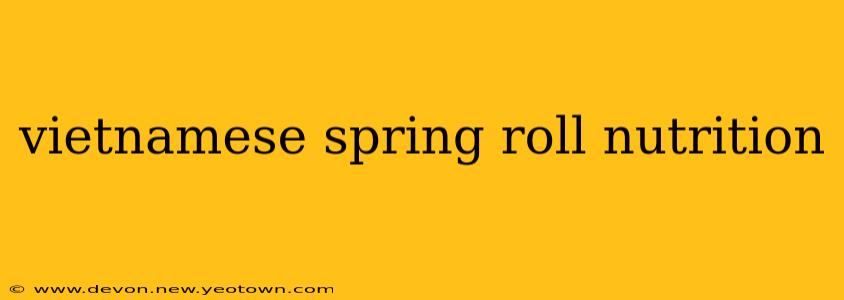The vibrant colors and fresh flavors of Vietnamese spring rolls, also known as gỏi cuốn, beckon from countless menus and street corners. But beyond their delightful taste, these delicate rolls offer a surprisingly nutritious profile. Let's dive into the nutritional details and uncover why gỏi cuốn can be a guilt-free pleasure in your diet.
My journey into the world of Vietnamese cuisine began with a simple spring roll. The crisp lettuce, the sweet shrimp, the fragrant herbs – it was a revelation. Since then, I've explored countless variations, learning that the nutritional content can vary widely depending on the ingredients. This guide will help you navigate the nutritional landscape of these delicious rolls.
What are the main ingredients in a Vietnamese spring roll?
Typically, Vietnamese spring rolls consist of rice paper wrappers filled with a medley of fresh ingredients. This usually includes:
- Rice paper wrappers: These are low in calories and provide carbohydrates for energy.
- Vermicelli rice noodles: A good source of carbohydrates and fiber.
- Lettuce: Packed with vitamins A and K, and fiber.
- Fresh herbs: Such as mint, cilantro, and basil, contributing vitamins, minerals, and antioxidants.
- Protein: This can vary greatly depending on the filling; common choices include shrimp, pork, tofu, or chicken.
How many calories are in a Vietnamese spring roll?
The calorie count of a Vietnamese spring roll can fluctuate significantly based on the ingredients. A smaller spring roll with predominantly vegetables and a lean protein source might contain around 100-150 calories. However, a larger roll with more noodles, richer proteins like pork belly, or added sauces could easily exceed 200-300 calories.
Are Vietnamese spring rolls healthy?
Generally, yes! Vietnamese spring rolls are a relatively healthy option compared to many other appetizers or snacks. They are low in saturated fat and cholesterol, particularly when filled with lean proteins and plenty of vegetables. The abundance of fresh herbs and vegetables contributes significant vitamins, minerals, and fiber to your diet.
What are the nutritional benefits of Vietnamese spring rolls?
The nutritional benefits depend on the specific ingredients, but some key advantages include:
- High in vitamins and minerals: The variety of fresh vegetables and herbs contributes essential vitamins like A, K, and C, as well as minerals like iron and potassium.
- Good source of fiber: The vegetables, rice noodles, and herbs provide dietary fiber, which aids digestion and promotes satiety.
- Lean protein source: Many fillings offer lean protein, supporting muscle growth and repair. However, be mindful of high-fat protein choices.
- Low in saturated fat and cholesterol: Compared to many fried appetizers, spring rolls are a relatively low-fat option.
Are Vietnamese spring rolls gluten-free?
Yes, traditional Vietnamese spring rolls are naturally gluten-free, as long as you avoid any sauces or additions containing gluten. Always double-check the ingredients of any added sauces to be certain.
Are Vietnamese spring rolls suitable for weight loss?
Vietnamese spring rolls can be part of a weight-loss diet, especially when filled with plenty of vegetables and lean protein sources. However, portion control is crucial, and it's important to be mindful of the calorie content, especially if adding high-calorie sauces or fillings.
What are some healthier variations of Vietnamese spring rolls?
To maximize the health benefits:
- Load up on vegetables: The more vegetables, the more vitamins, minerals, and fiber you'll get.
- Choose lean protein sources: Opt for grilled chicken, shrimp, or tofu instead of fatty meats.
- Go easy on the noodles: Reduce the amount of vermicelli noodles to decrease the carbohydrate content.
- Limit sauces: Sauces can add significant calories and sodium. Opt for light dipping sauces, or make your own with lime juice and herbs.
Ultimately, Vietnamese spring rolls offer a delicious and relatively healthy option, but as with any food, moderation and mindful ingredient selection are key to maximizing their nutritional benefits. Enjoy them as part of a balanced diet for a truly delicious and nutritious experience!

